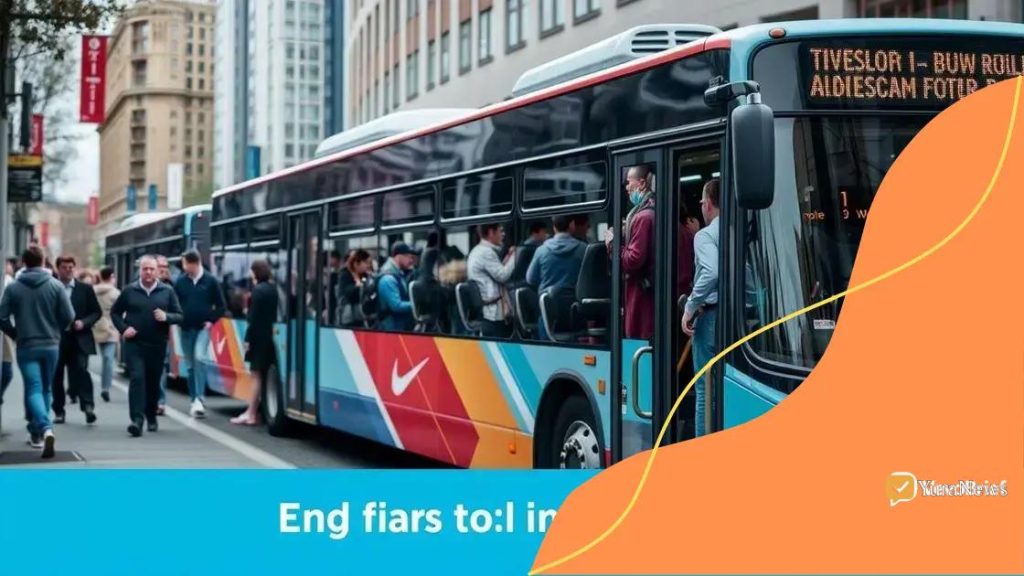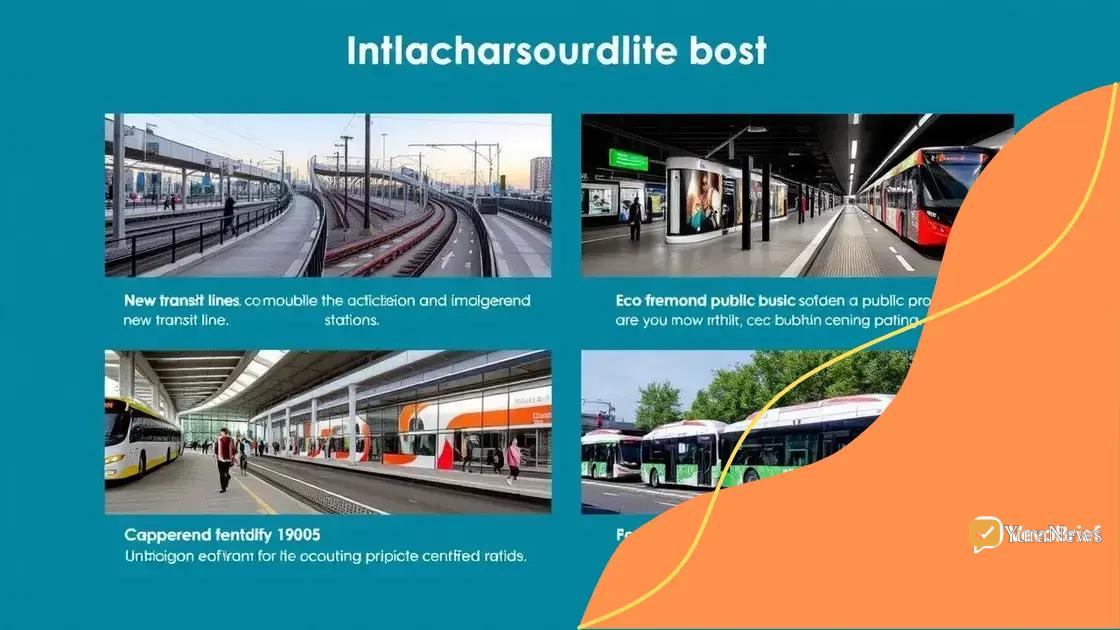Federal funding for public transit projects benefits communities

Anúncios
Federal funding for public transit projects enhances transportation accessibility, supports economic development, and promotes sustainability through investments in new transit lines, technology upgrades, and green initiatives.
Federal funding for public transit projects announced is set to transform urban mobility. Have you thought about how these initiatives can enhance your daily commute and overall access to services? Let’s dive into the details.
Anúncios
Understanding federal funding for transit
Understanding federal funding for transit is essential for grasping how these initiatives can improve our cities. Federal grants play a crucial role in financing various public transportation projects, ensuring that communities have reliable transport options.
What is Federal Funding?
Federal funding refers to the financial resources allocated by the government to support public transit initiatives. This funding is typically sourced from taxes collected at the federal level. It helps localities enhance their transit systems, ensuring they meet the needs of their populations.
Benefits of Federal Funding
- Improves accessibility for residents.
- Encourages the use of public transportation.
- Supports economic growth in communities.
Furthermore, when communities receive this funding, they can invest in infrastructure, such as new bus routes and train lines. These advancements often lead to more efficient and convenient transit options for everyone. Additionally, improved public transit can reduce traffic congestion and environmental impact.
Anúncios
Another significant advantage of federal funding is the potential for job creation. Many public transit projects require skilled labor, thus creating employment opportunities in the community.Valuing public transit not only benefits individual riders but also supports overall community development.
How Funds are Allocated
The allocation of federal funds typically follows specific guidelines set by government agencies. Each year, agencies like the Federal Transit Administration (FTA) examine proposals from local transit authorities. These proposals must demonstrate how the funds will enhance services and meet community needs.
Proposals are assessed based on factors such as projected ridership growth, community engagement, and the environmental impact of the projects. By aligning funding with community needs, federal funding initiatives strive to create a more sustainable and user-friendly transit system.
In summary, understanding federal funding for transit helps reveal how vital these resources are for enhancing transportation options. With increased accessibility, reduced congestion, and job creation, it’s clear that such funding is beneficial for individuals and communities alike.
Impact on local communities
The impact on local communities from federal funding for public transit projects is profound. Through these initiatives, communities can enhance their transportation options, which leads to better accessibility and convenience for residents.
Improved Accessibility
With the influx of federal funds, local transit authorities can expand routes and services. This means more people can reach jobs, schools, and essential services more easily. Enhanced accessibility encourages individuals to use public transportation rather than relying on personal vehicles.
Economic Development
- Increased job opportunities due to improved transit.
- Attraction of businesses to areas with reliable transportation.
- Boost in local tourism as transit systems improve connectivity.
Moreover, when public transit is reliable, it draws businesses and stimulates local economies. Communities with robust transit options often attract new companies, which in turn creates job opportunities for residents. Additionally, this can make neighborhoods more appealing to tourists, promoting local attractions.
The social fabric of communities also gets strengthened. Access to public transport can help connect various demographics, allowing diverse populations to interact and share spaces. Improved transit systems foster inclusivity and promote community engagement, making neighborhoods vibrant and connected.
Environmental Benefits
Investing in public transit projects also leads to significant environmental benefits. By encouraging more people to use buses and trains instead of cars, we can reduce traffic congestion and lower greenhouse gas emissions. As the number of transit users rises, communities can enjoy cleaner air and a healthier environment.
Through these methods, it is clear that the impact of federal funding goes beyond mere transportation. It remaps the community landscape, creating a more accessible, connected, and environmentally friendly future for everyone.
Types of public transit projects funded

Understanding the types of public transit projects funded through federal sources is vital. These projects play a key role in enhancing transportation systems across various communities. Federal funding is typically allocated to a range of projects, each designed to improve transit efficiency and accessibility.
New Transit Lines
One major type of funded project is the construction of new transit lines. This includes adding railways, bus rapid transit (BRT) systems, or light rail services. These new lines aim to extend the reach of public transit, making it easier for residents to access employment opportunities and services.
Station Improvements
- Upgrading existing transit stations.
- Enhancing accessibility features.
- Adding amenities like Wi-Fi and seating.
Improvements to transit stations are also a significant focus. Investments often go towards upgrading facilities to enhance user experience. Ensuring that stations are accessible is crucial, as it allows everyone, including individuals with disabilities, to use public transit effectively.
Another area of focus is the development of maintenance facilities. These facilities ensure that public transit vehicles are serviced and operational, which is essential for maintaining a reliable service.
Transit Technology Upgrades
Investment in technology is increasingly important in public transit projects. This can include implementing real-time tracking systems, mobile ticketing options, and improved communication tools. Such upgrades enhance user experience by providing accurate information, reducing wait times, and streamlining services. These technologies not only help passengers but also aid transit authorities in managing resources better.
Sustainability Initiatives
Funding may also target sustainability projects. This means investing in electric or hybrid buses, which help reduce carbon emissions. These initiatives aim to create a more environmentally friendly transit system while also addressing climate change concerns.
These types of projects collectively help shape the landscape of public transit by providing better services and promoting community development. Through federal funding, communities get the necessary support to improve their transit infrastructures, making a difference in daily life for residents.
How to apply for funding
Applying for federal funding for public transit projects can be a detailed process. Understanding how to apply for funding is crucial for local transit authorities and organizations seeking support for their initiatives. The application process involves several key steps that ensure proposals meet the necessary requirements.
Research Funding Opportunities
The first step in applying for funding is researching available opportunities. Different federal agencies, such as the Federal Transit Administration (FTA), offer a variety of funding programs. Each program has its specific goals and eligibility criteria.
Prepare a Comprehensive Proposal
- Clearly identify the needs of your community.
- Outline the project objectives and benefits.
- Include a detailed budget showing projected costs.
A well-prepared proposal is essential. It should clearly identify the needs of your community and explain how the project will address these needs. The objectives should be specific, measurable, achievable, relevant, and time-bound (SMART). A detailed budget is also necessary, as it shows how the funding will be used effectively.
Engaging the community in the proposal process can help strengthen the application. Gathering public input can provide insights into the community’s needs and preferences. This can also demonstrate broad support for the project, which is often a critical factor in funding decisions.
Submit the Application
After finalizing the proposal, the next step is to submit the application. Federal agencies usually have specific submission guidelines and deadlines. Be sure to follow these closely, as failure to comply can result in disqualification.
Once submitted, the application will undergo a review process. During this period, agencies may reach out for additional information or clarification. Being responsive and providing the needed details promptly can improve the likelihood of funding approval.
Follow Up
After submission, it is important to follow up on the application status. Understanding any feedback or inquiries during the evaluation process helps keep lines of communication open. If the proposal is not funded, agencies often provide feedback that can be valuable for future applications.
In summary, knowing how to apply for funding involves thorough preparation, community engagement, and diligent follow-up. By carefully navigating this process, organizations can increase their chances of securing the necessary resources to improve public transit in their communities.
Future outlook of transit funding initiatives
The future outlook of transit funding initiatives looks promising as communities increasingly recognize the importance of robust transportation systems. With growing concerns about climate change and urban congestion, the demand for efficient public transit is on the rise.
Enhanced Funding Opportunities
As policies evolve, new funding opportunities are expected to emerge. The federal government is likely to allocate more resources to support sustainable transit projects. This includes funding for electric buses and renewable energy initiatives, which aim to reduce the carbon footprint of public transportation.
Community Engagement and Support
- Increased public awareness of transit benefits.
- Community-driven projects gaining momentum.
- Focus on equity and accessibility.
Community engagement will play a vital role in shaping future transit initiatives. As citizens become more aware of the benefits of public transport, support for funding initiatives is likely to increase. Local grassroots movements will help promote projects that prioritize equity and accessibility, ensuring that all community members benefit from improved transit systems.
Technological advancements will also influence the future of transit funding. Innovations, such as real-time tracking systems and integrated payment solutions, are becoming essential features of modern transit. Funding will increasingly support projects that incorporate these technologies, making transit more user-friendly and efficient.
Sustainability Goals
A significant focus will remain on sustainability in transit funding. Many cities are setting ambitious goals to achieve net-zero emissions in public transport. This shift will push for investments in greener technologies, such as electric vehicles and improved infrastructure for pedestrian and cycling paths.
Moreover, strategic partnerships between public and private sectors may emerge, providing additional funding sources. Collaborations can lead to innovative transit solutions that meet community needs while ensuring long-term financial sustainability.
In summary, the future of transit funding initiatives points towards more dynamic and inclusive solutions. With an emphasis on sustainability, community engagement, and technological innovation, these initiatives hold the potential to significantly enhance public transportation systems in the coming years.
In conclusion, understanding the landscape of federal funding for public transit projects is essential for communities aiming to enhance their transportation systems. By focusing on accessibility, economic development, and sustainability, these initiatives not only improve transit services but also benefit the environment and local economies. As we look ahead, increased funding opportunities, community engagement, and innovative technology will play significant roles in shaping the future of public transit. With the right approaches, we can build more inclusive, sustainable, and efficient transit options for all community members.
FAQ – Frequently Asked Questions about Federal Funding for Public Transit
What types of projects can receive federal funding for transit?
Federal funding can support projects like new transit lines, station improvements, technology upgrades, and sustainability initiatives.
How can communities engage in the transit funding process?
Communities can engage by providing input during proposal preparation, showing support for projects, and participating in public meetings to voice their needs.
What role does technology play in public transit funding?
Technology enhances transit services by improving efficiency, providing real-time data, and enabling better user experiences through smart solutions.
How important is sustainability in future transit projects?
Sustainability is crucial as future projects aim to reduce environmental impact by investing in green technologies and renewable energy solutions.